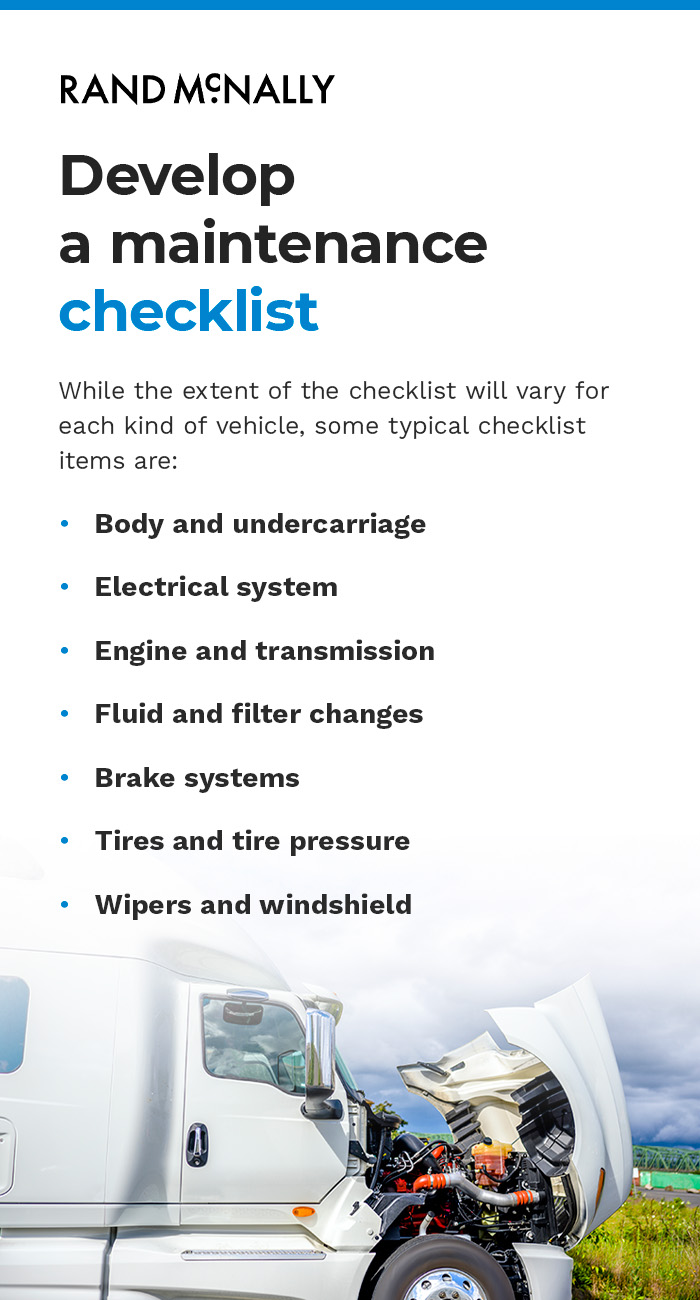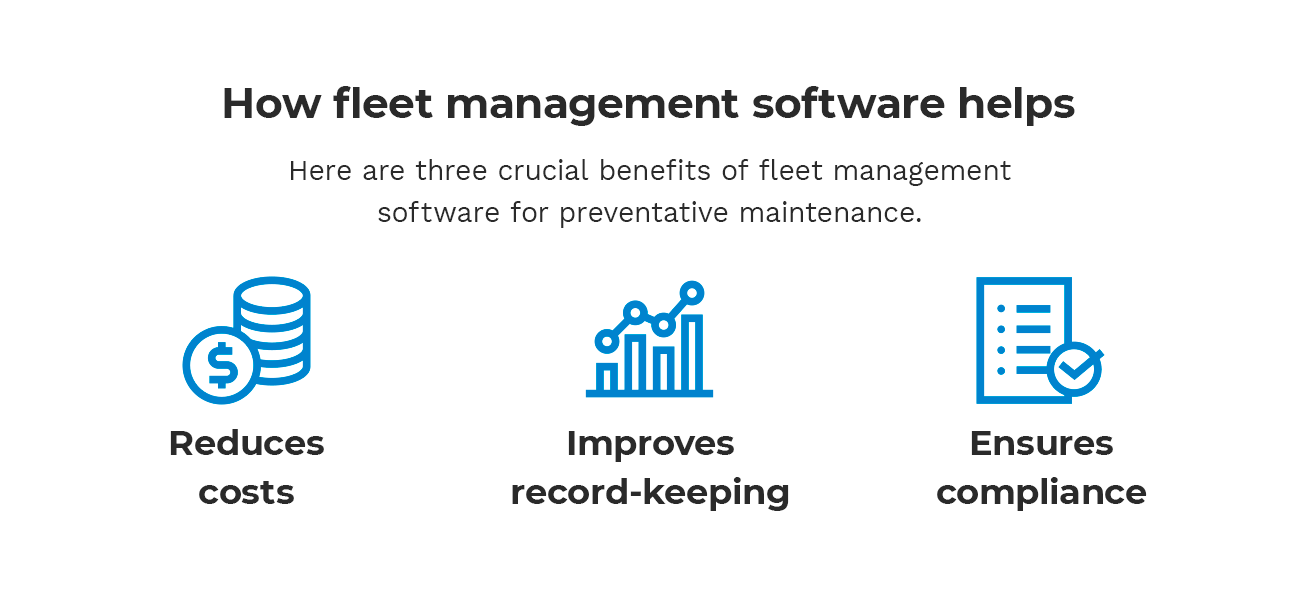The Ultimate Guide to Fleet Maintenance
As a whole, fleet management is a complex job that involves numerous variables and responsibilities. It's no wonder most fleet managers feel lost without a comprehensive guide to fleet preventative maintenance to help them reduce costs and increase productivity.
This fleet maintenance guide covers the importance of having a preventative maintenance plan, how to develop your own fleet maintenance strategy, and which best practices to implement that will optimize your time. With robust fleet management software solutions, your fleet can achieve reduced downtime and prolonged vehicle lifespan. Keep reading to learn more from our fleet vehicle maintenance management guide.
Why Fleets Need a Preventative Maintenance Plan
Fleet managers need a comprehensive fleet maintenance plan to reduce costs, improve productivity, and enhance safety and compliance levels. Well-maintained fleets are capable of providing reliable service, whether it's in transportation, construction, or any other industry. While a preventative maintenance plan can't entirely eliminate unforeseen issues, it can give your business the upper hand and provide peace of mind.
Fleet managers must consider the importance of preventative maintenance planning for fleets and how it can provide the following benefits.
Minimize Costs
Fleet preventative maintenance plans are a proactive and effective way for businesses to better manage their overhead costs. Businesses can't thrive in unpredictable environments, so having a maintenance schedule in place allows managers to account for fleet expenses in advance.
Effective fleet maintenance plans allow managers to budget for routine maintenance on an ongoing basis. Preventative maintenance schedules also let managers know which parts are due for replacement and when replacement needs to happen. Rather than reacting to breakdowns, technicians can replace worn parts ahead of time, which is far less expensive in the long run than the alternative.

Extend Vehicle Lifespan
Having a fleet maintenance plan mitigates unforeseen expenditures and improves the value of the fleet vehicles. Properly maintained fleet vehicles have a longer service life than vehicles that don't undergo routine maintenance. Businesses that take the time to develop a fleet preventative maintenance plan will earn a higher return on investment (ROI) from their fleet.
Additionally, many vehicles begin to become less fuel-efficient over time. Maintaining your fleet vehicles will improve service life, allowing you to benefit from their good working condition and better fuel economy for longer.
Mitigate Liability
It's crucial to emphasize the importance of preventative maintenance for fleets, especially in terms of liability. Properly maintained vehicles are far safer and more reliable and predictable. Having properly maintained vehicles on the road can drastically reduce the chances of safety hazards. Cracked windshields, worn brake pads and rotors, bald tires, and failing electrical systems are all vehicle maintenance issues that can lead to motor vehicle accidents.
When it comes to legal matters, businesses that fail to maintain their vehicles can be liable for accident costs if the vehicle's poor maintenance record contributed to the incident. Ensuring vehicles are adequately and routinely maintained can help your company prevent costly accidents and achieve lower CSA scores for your fleet.
Improve Productivity
When you plan your fleet's servicing schedule, you can eliminate unproductive downtime. Having a preventative maintenance plan allows managers to put fleet vehicles into a scheduled rotation. When maintenance activities are scheduled this way, it allows you to make other vehicles available during one vehicle's maintenance slot.
Without a preventative maintenance plan, companies can suffer serious interruptions to their service delivery when a vital fleet vehicle breaks down unexpectedly. Often these sudden issues take longer to repair, meaning your vehicle could be out of commission for an extended time, making you lose money.
How to Develop a Fleet Maintenance Strategy
To benefit from preventative maintenance, companies need a fleet maintenance strategy. With numerous vehicles to manage, all requiring different servicing needs at different times, it's not always easy for managers to keep track of maintenance requirements without a plan.
Having a plan helps you record each vehicle's needs and define systems and processes for conducting routine maintenance. All team members involved in fleet management, from drivers to technicians, can stay on the same page when there's a preventative maintenance plan in place.
Fleet managers wondering how to develop a fleet preventative maintenance plan should follow the following four steps.
Know Your Vehicles
There's no one-size-fits-all preventative maintenance plan for fleet vehicles. Companies that understand how to build a fleet maintenance plan know their vehicles' unique needs. Managers should assess the general servicing needs of each class of vehicle, including light- and heavy-duty vehicles, and make a tailored plan from there.
Your preventative maintenance plan will depend on many variables. First, the current age of the vehicles will determine the amount and frequency of service. Newer vehicles have much more efficient engines, often lubricated with synthetic oils that need changing less often than with older engines.
In addition to the vehicle age, the level of usage your vehicles undergo will also determine how to build a fleet preventative maintenance plan. If drivers are operating vehicles in rugged conditions, routinely carrying heavy loads, or being driven by multiple different drivers, you'll need to adjust your preventative maintenance plan to account for this variability.
Develop a Maintenance Checklist
Adhering to a preventative maintenance plan is a lot easier for companies with systems in place to make maintenance more efficient. One of the simplest systems to implement as part of your fleet maintenance management strategy is the checklist. A preventative maintenance checklist should consist of all the activities that need to be addressed during a scheduled maintenance interval.

Your vehicle owner's manual can help you identify the items you should include on your preventative maintenance checklist. While the extent of the checklist will vary for each kind of vehicle, some typical checklist items are:
- Body and undercarriage
- Electrical system
- Engine and transmission
- Fluid and filter changes
- Brake systems
- Tires and tire pressure
- Wipers and windshield
Following a checklist ensures full preventative maintenance from top to bottom.
Schedule Preventative Maintenance Intervals
The purpose of a preventative maintenance plan is to schedule them on an ongoing basis. How often a vehicle undergoes planned maintenance depends on the vehicle and its usage level. Typically, service intervals are scheduled based on measurable milestones, such as mileage or hours of operation. Additionally, some maintenance items need to be addressed more frequently than others. For example, oil changes occur more often than tire replacements.
A comprehensive preventative maintenance plan schedules each item on the maintenance checklist in its appropriate interval. Each vehicle needs its own maintenance schedule, so it's important to gather specific information, including current age, mileage, and hours of operation. Based on this information, you can schedule each vehicle's maintenance activities throughout the upcoming calendar year.
Plan for Reactive Maintenance
Fleet managers can do all the right things, including adhering diligently to a checklist and schedule, and still experience unforeseen issues. Therefore, fleet managers wondering how to develop a fleet preventative maintenance strategy should factor in reactive maintenance.
How can you plan for the unknown? By understanding that a breakdown may happen at any moment, you can develop a plan B. Fleet managers should be equipped with a backup plan to address the sudden breakdown of any given fleet vehicle. Managers need to have technicians readily available and a streamlined process for fast parts ordering. They also need to have a clear understanding of how they'll rapidly adapt to limit downtime, such as rescheduling services or extending driver shifts.
Fleet Maintenance Best Practices
In addition to knowing how to develop a fleet maintenance plan, fleet managers must also implement fleet vehicle maintenance best practices to achieve that plan. Following industry-standard fleet preventative maintenance best practices helps your company stay competitive and deliver superior and reliable service, all while maintaining high levels of regulatory compliance and safety.
Below are four fleet maintenance management best practices for businesses to follow.
Invest in Reliable Vehicles
The first thing a business can do to mitigate its maintenance costs and manage risk is to invest in the right vehicles from the start. However, it's not always easy for managers to know which vehicles will serve their business needs best. Fleet management approaches tend to change over time, meaning the vehicle that worked best at one point may no longer be suitable for the current model.
Part of following any guide to fleet maintenance management is to look at long-term outcomes. By continuously measuring vehicle performance as a function of its maintenance activities, you can gain clear insight into which vehicles perform better. Additionally, when measuring these values, you'll notice whether certain models are more susceptible to chronic wear and tear. Having a way to track vehicle performance allows you to make wiser future investments in fleet vehicles and maintenance management practices.
Get Driver Buy-In
Your drivers are your first line of defense in your fleet maintenance strategy. Since they interact with the vehicles more than anyone else, involving them in the fleet preventative maintenance process just makes sense.
There are several roles drivers can play to assist in the maintenance management process. Here are ways to increase driver buy-in:
- Train drivers to perform daily inspections and give them the reporting tools they need to track their inspection findings.
- Give drivers a way to flag and communicate complaints immediately before a breakdown occurs.
- Provide drivers with feedback on any driving habits that may be contributing to maintenance issues and ensure they receive support in resolving problematic behaviors.
- Promote a culture of safety by empowering drivers to take ownership over vehicle performance.
Fleet management is a team effort, and drivers play a valuable role in ensuring the success of all maintenance programs.
Outsource Fleet Maintenance
Outsourcing fleet maintenance to a third-party provider is a financially prudent move for most small to medium-sized businesses. Vendors have greater buying power for parts replacements, and this move can free up internal resources to invest in other areas of fleet management. However, like all vendor relationships, it's a matter of partnering with one that shares your goals.
Businesses should partner with local vendors that have certified technicians with extensive experience in fleet maintenance. When securing vendor partnerships, it's important to establish an open and thorough communication process. The right fleet management software that helps fleet managers and technicians streamline work orders and share preventative maintenance schedules can help.
Improving cooperation between the two parties drastically minimizes downtime, increasing the effectiveness of the preventative maintenance program. Vehicles receive the necessary servicing quickly and efficiently, and fleet managers still retain control over the overall maintenance plan.
Go Digital
No fleet vehicle maintenance guide would be complete without mentioning the crucial role digital technology plays in an intelligent fleet maintenance program. Digital management systems give your business detailed insight into the effectiveness of your maintenance activities — something you can't achieve with a pen-and-paper method.
Today's fleet management software systems alleviate time-consuming duties that fleet managers are accountable for. Intelligent software tracks, plans, and assesses maintenance activities, revealing actionable data that can help you improve your overall fleet management program.
Technologies like vehicle analytics provide you with a fleet preventative maintenance guide that helps you stay on top of maintenance activities, lower your CSA scores, and improve overall operations. Digital systems streamline your fleet maintenance strategy, freeing up your time and resources to further grow your business.

How Fleet Management Software Helps
Fleet management software is a comprehensive technology solution that helps fleet managers make smarter, more informed decisions about their overall fleet. From risk management to productivity, fleet management software helps you lower costs, streamline record-keeping, and enhance compliance, especially when it comes to a fleet's preventative maintenance activities.
Here are three crucial benefits of fleet management software for preventative maintenance.
Reduces Costs
Fleet management software helps companies improve their bottom line. With vehicle maintenance software, managers can identify upcoming parts replacements and schedule routine maintenance activities well in advance. Having an efficient planned maintenance program significantly reduces the risk of sudden and unexpected breakdowns, which are time-consuming and costly to address.
With fleet maintenance insights, you can stay on top of each vehicle's routine maintenance schedule and respond faster to any issues that suddenly arise. Fleet preventative maintenance technology helps you be more effective at vehicle management, directly contributing to your bottom line.
Improves Record-Keeping
If you manage a fleet of vehicles, you know how crucial it is to maintain thorough records of all fleet activity, including maintenance. Scrupulous record-keeping helps you prepare for inspections, audits, and other compliance and legal requirements. Relying on a software management program can help improve your internal documentation processes so your fleet can achieve and maintain compliance.
Vehicle analytics software logs all maintenance activity and tracks vehicle performance, arming you with data you can use to enhance your fleet's productivity. You can use these records to identify vehicle patterns and make smarter decisions moving forward.
Ensures Compliance
The outcome of improved maintenance planning is that it brings your fleet to higher compliance standards. Fleet management software gives you insight into ways to directly improve your fleet's maintenance plan to achieve higher safety standards, including CSA scores.
To ensure your CSA scores are as low as possible, you need to dedicate resources to enhanced vehicle maintenance planning. Fleet management software helps you identify key violations that could prevent you from achieving a low CSA score.

Choose Rand McNally Fleet Management Solutions
With this fleet maintenance management guide, you’re on your way to more effective fleet management, reduced maintenance costs, and improved safety and compliance standards. Taking a smart approach to fleet maintenance planning allows managers to free up their time and increase their fleet's productivity.
Rand McNally Fleet provides businesses with essential fleet management tools. With a comprehensive vehicle analytics solution, fleet managers can record, schedule, and access crucial fleet performance information that keeps maintenance cost-effective and efficient. To learn more about our comprehensive fleet management software, request a demo today.
Contact Rand McNally
Request Pricing for Fleet Solutions
We're looking forward to talking with you. Please fill out the form to get started.
Or call us:
+1 (800) 789-6277 (Fleet management, ELD, Asset tracking, Navigation)
+1 (800) 234-4069 x2 (MileMaker/IntelliRoute)
If you are an existing customer and need assistance, please contact your Client Success rep or email fleetsupport@randmcnally.com.
This form is for business-to-business transactions only. It is not for personal consumer use.


